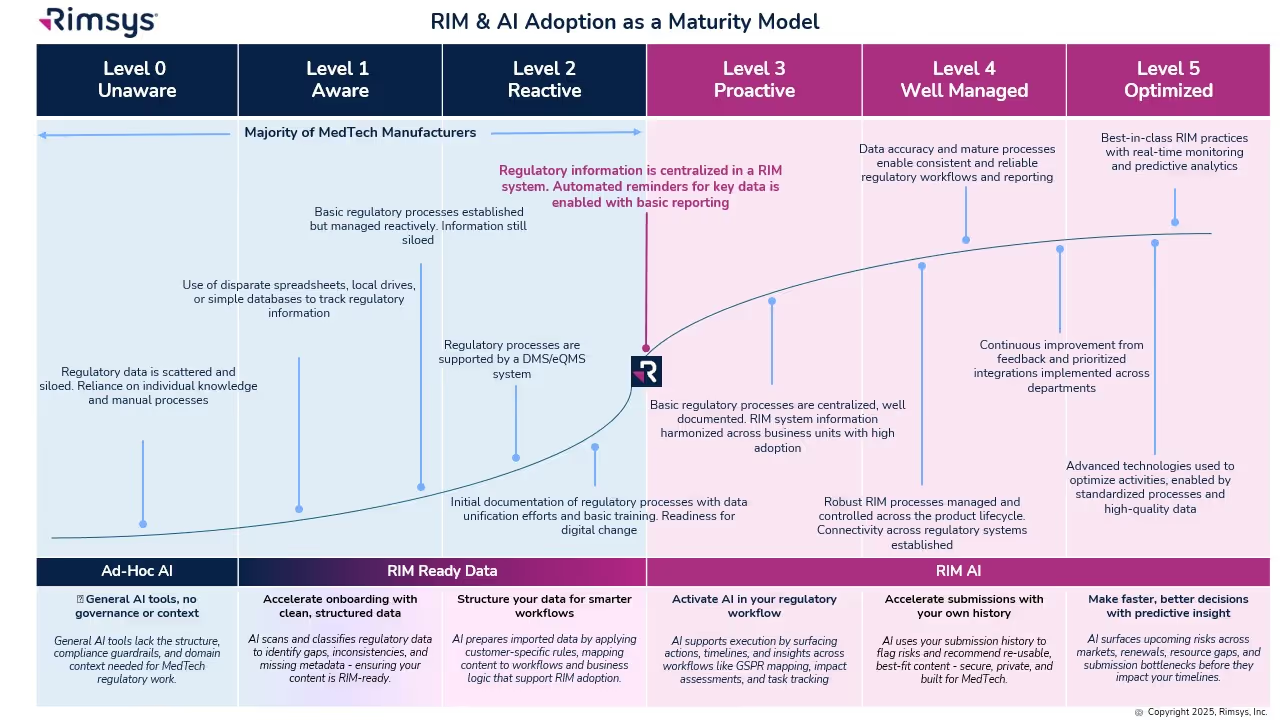
Large medtech companies often have data stored in multiple ERP, PLM, and eQMS systems due to mergers, acquisitions, and siloed growth within product teams and departments. While segmented data can cause issues for everyone, it provides particularly concerning obstacles for regulatory affairs teams. RA teams in large organizations typically manage multiple product lines with various levels of classification across many global markets. When product and registration data is not centralized, regulatory teams will not only encounter significantly more complex processes related to managing and controlling data properly, but will also struggle to find and organize the data needed for submissions, license renewals, and other standard RA activities.
Regulatory data management issues without RIM
- Maintaining validation records for multiple systems: In the highly regulated world of medical technology, manufacturers are required to fully validate any system used to design, develop, or manufacture a medical device. Among other things, manufacturers must be able to demonstrate that only the current, approved version of a device can be manufactured. System updates and other changes trigger a re-validation process, which becomes increasingly complex as the number of systems increases. Not only does the system that is being changed need to be validated again, but any other system and process that is using data from the updated/changed system may need to be validated again as well. Issues with data integration between systems is a common finding during quality and regulatory audits.
- Ensuring data accuracy: As mentioned above, validating systems becomes exponentially more complex as the number of systems increases. In cases where the same data is stored in more than one system, the possibility exists that the data is not synchronized in real-time. Whether data is automatically transferred between systems or requires manual data entry or integration steps, each integration point is a possible point of failure. Regulatory and quality teams need to ensure that they identify the “source of truth” for each piece of data that is duplicated and that they can demonstrate the processes that ensure data integrity is being maintained.
- Managing user access: Managing user permissions in large systems, such as ERP solutions, often involves setting specific permission levels for a large number of detailed system functions. Users with access to information in one system may not have access to the same information in another system, causing auditing issues and creating difficulty in administering user credentials. For example, does a user have access to add regulatory documentation, such as EU MDR technical files or medical device certificates, into the system? If not, many companies end up circumventing their own systems by also using SharePoint or other shared drives to store updated files – where they may get lost or overlooked.
- Establishing system-related processes: Establishing and maintaining processes for system issues, downtime, updates, and other regular maintenance is impacted by the number of systems and the ways in which they are integrated. Regulatory teams won’t control these processes for non-regulatory systems, but may require access to data in these systems for time-critical tasks.
Regulatory workflow issues without RIM
Regulatory affairs professionals are familiar with the massive, color-coded spreadsheets that are often central to maintaining medical device registration information. While those spreadsheets work in some situations, without a centralized RIM system RA teams face two large challenges:
Software solutions not built for regulatory teams
- Spreadsheets are not the answer: While those large spreadsheets can be sufficient in smaller companies with a few products in a few markets, they quickly become unwieldy. Regulatory teams managing multiple submissions projects across global markets are compiling large amounts of information into specifically formatted portfolios for each country – a process that is difficult, at best, to manage with spreadsheets and pdf documents.
- Non-compliance risks: Regulatory teams that are managing data without a centralized RIM solution also run the risk of identifying changes and expiration dates too late, leading to higher consultant costs and the risk of non-compliant products.
- Missed opportunities: Most regulatory teams do an amazing job keeping multiple projects on track, products in compliance across the globe, and their company prepared for audits and inspections. What if, however, regulatory teams had access to a centralized regulatory system that could provide them with the information, and the time, to contribute to strategic product marketing and staffing decisions? We believe that an organization with a revenue-aligned, strategic regulatory team has a competitive advantage in the marketplace. Read more in our ebook, Regulatory Strategy as a Competitive Advantage.
Regulatory data in multiple systems
We know that 70% of regulatory teams spend at least half of their time on repetitive administrative tasks. Much of this is because the data they need is stored in multiple systems across the organization, with the same data often being stored in multiple places. This leads to an increased chance of outdated information being used, required data being missed, and difficulties in proving that the data management processes in place are sufficient for ensuring accuracy.
The information required by regulatory teams comes from teams throughout an organization, including product data from the engineering team, production and supplier information from the manufacturing team, quality records from the QA team, clinical trial data from the clinical team, and more. This is all in addition to the regulatory submissions, changes, and agency communications managed by the RA team themselves. Without a centralized system to record and reference all of this data, regulatory teams are left to a lot of research, searching, and duplication of efforts across the team.
Data warehouses as an option
In cases where there are multiple, enterprise-level systems sharing the same data, a data warehouse is often used. Data warehouses provide a centralized system in which to store data and maintain that single “source of truth” that all systems can pull data from. However, these systems can be extremely expensive and complex to set up and maintain. They normally require a team of consultants or internal staff to manage the setup and maintenance of the warehouse, including complex ETL (extract, transform, and load) workflows. These workflows are required because data stored in multiple systems will almost never be in the same format and will need to be “transformed” before being loaded into the data warehoused.
In addition, data warehouses are not typically updated in real-time and require that data cleaning and verification procedures run before data is uploaded. This makes a data warehouse a poor option for data that is needed for daily workflows and processes, such as UDI data management.
Regulatory Information Management (RIM) systems as a better option for master regulatory data management
Regulatory Information Management (RIM) systems, such as Rimsys, are designed to be the central source of truth for regulatory information. Purpose-built for regulatory teams, RIM solutions are powerful because they provide:
Centralized, product-centric, regulatory data
Information and data that is specific to regulatory activities can be stored and accessed directly in the RIM solution. This includes information such as submission documents, registration certificates, product references to standards and essential principles, and regulatory authority communications. The RIM solution is the original “source of truth” for this information.
As a result, RIM solutions provide regulatory teams with control over critical data, such as “available to sell” flags at a product version and country or market level. This ensures that the regulatory team is managing a product’s availability to be sold, market-by-market, based on its regulatory status in each market.
Integrated data
Regulatory teams require data from across the organization to manage submissions and other regulatory activities. A strong RIM solution will provide for integration with PLM, eQMS, eDMS, ERP, and other solutions that typically house information used by regulatory teams. For example, the design and engineering teams will likely utilize a PLM system to manage product details and revisions. While that data is needed by the regulatory team, it is owned by the design and engineering teams and belongs in their PLM system.
Rimsys provides secure API endpoints that simplify integration with nearly any system with a REST API.
Rimsys also simplifies compliance with 21CFR part 11 and other regulations by providing complete and easy-to-read activity logs for all actions taken within the software.
To learn more about how Rimsys can be your master data management system, schedule a time with one of our product experts to see Rimsys in action.
Similar posts







.avif)


